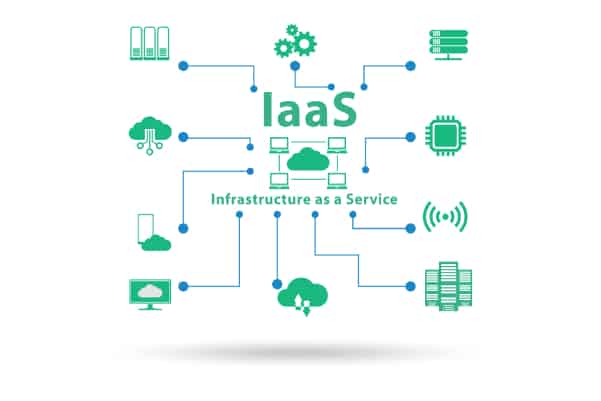Sign up today for a Free Rapid Assessment in just a few easy steps and start maximizing your technology investments. Request your free assessment now!

While the infrastructure and computing resources that run today’s businesses − such as storage, hardware, servers, and networking components − are critical, they are often underrated when it comes to being ranked as business priorities. That’s because, although the infrastructure is expected to perform predictably and reliably to support the business, it is not necessarily viewed as being a differentiator that delivers a competitive advantage. This belief, however, is far from the truth. In fact, today’s industry leaders are turning to infrastructure and infrastructure services to help them drive efficiencies and power digital transformation across their businesses.
One way they are doing this is by utilizing the Infrastructure-as-a-Service (IaaS) model. IaaS is a cloud computing model where an organization outsources the fundamental infrastructure equipment used to support operations, i.e., storage, hardware, servers and networking components, and access to computing resources is delivered through a virtualized, cloud-based environment. This creates a joint delivery model where organizations own “up stack” from the virtual machine, but everything required to run that virtual machine is managed and maintained by someone else.
According to Statista, the worldwide IaaS market will reach $122 billion by 2022. Not only that, the market is dominated by big players. Studies report 66% of the IaaS market is served by AWS (Amazon Web Services), Microsoft Azure, Alibaba and GCP (Google Cloud Platform). With IaaS, instead of purchasing hardware outright, users access virtualized computing resources over the internet, with the flexibility to scale up and down resources as circumstances and priorities change.
IaaS delivery options include the public cloud, private cloud or a hybrid cloud model. More companies are turning to a hybrid cloud approach to reach the optimal balance between cost and flexibility, in order to have the ability to move workloads between the private and public infrastructure as needed.
Benefits of IaaS are the reduction of hardware infrastructure costs coupled with greater flexibility and business agility, with pay-as-you-go pricing models that let the users pay only for the services they consume. Because businesses can spin up resources quickly, developers are also free to run temporary workloads, test new applications or prepare for seasonal spikes in traffic.
Ready to get more out of your technology while saving money? Bluewave can help.
Also, a successful IaaS strategy can help companies focus on business growth and on meeting business-critical objectives. Let’s take a closer look at the best use cases for adopting IaaS:
In addition to providing day-to-day computing resources, IaaS allows users to layer a wide-range of services on top of the infrastructure. That might include computing-as-a-service, disaster recovery-as-a-service, analytics or BI-as-a-service, and more.
Managing, storing, and analyzing big data like structured data (i.e., databases) and unstructured data (i.e., social media, images, web, emails, Internet of Things (IoT) sensors) requires a significant amount of processing power. IaaS is a perfect environment to manage big data because it can handle large workloads and can integrate with business intelligence tools. This delivers business insights that can help users predict trends, improve relationships with customers, and create new products and services.
With a robust and scalable infrastructure layer, organizations can consolidate their disparate disaster recovery systems into one virtualized environment for disaster recovery. This diversification of the backup systems gives businesses peace of mind knowing that their data is secure.
The computing and networking power behind IaaS make it a perfect place to run and manage testing and development cycles. With SLAs in place from providers and a high-level of security, enterprises can trust IaaS to run business-critical projects and get to market faster with a higher scalability of computing resources.
Because the network continues to grow in complexity, many are turning to IaaS service providers to deliver networking-as-a-service support. This may be for a short-term big data project, or to support ongoing initiatives, freeing up internal IT staff for other priorities.
When deciding to move infrastructure to the cloud and evaluating service providers, look for those that match business requirements such as expertise, availability guarantees, price, and security certifications, for example. Those vendors that deliver 24/7 support and make it easy to move workloads to and from the cloud environment can help businesses improve efficiencies and differentiate themselves from the competition. Talk to Bluewave today about smart, flexible IaaS options that can be a game-changer for organizations big and small.
While IaaS has its place in a cloud computing strategy, it is far from the only tool organizations have. Software-as-a-Service (SaaS) applications are the most recognized cloud-based IT services category, and they include popular applications like Salesforce, MS Dynamics or Workday. A Platform-as-a-Service (PaaS) example would be a development platform that is used to build and run applications in the cloud. This might be comprised of application servers or database management systems.
Each model moves the demarcation of control to a different point in the computing stack, so it’s important to map the right as-a-service approach to the right business needs and align them with the right IT operations strategy. If you need help determining which cloud approach fits your needs, engage Bluewave to speak with one of our Technology Advisors today.
Follow us on LinkedIn
© 2025 Bluewave Technology Group, LLC. All rights reserved.